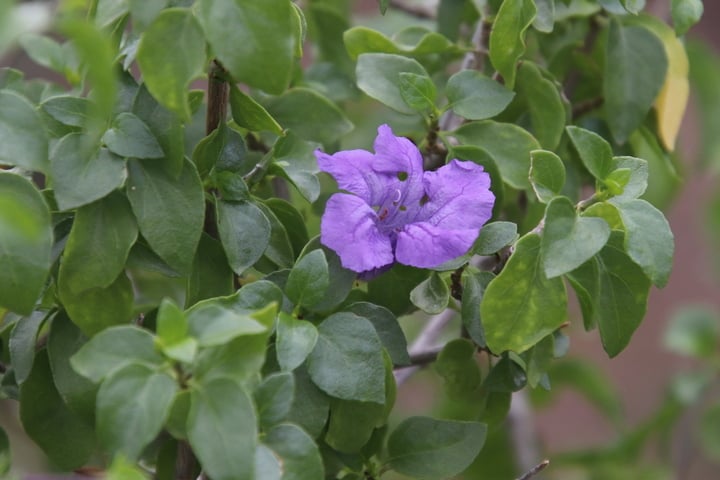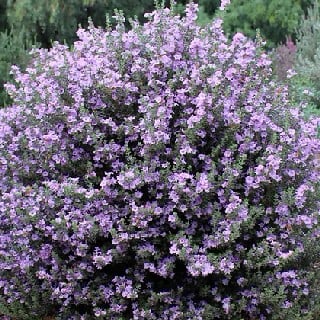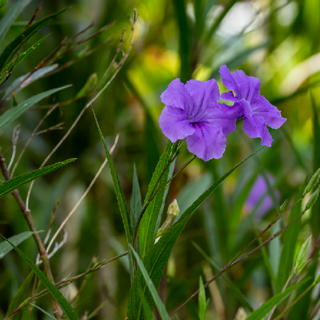If you’d like to grow a flowering shrub that looks like a Texas ranger, but stays a manageable size and flowers more consistently, consider Baja ruellia. Here’s how to plant and care for this lovely, but underutilized Sonoran Desert native.

Baja ruellia (Ruellia californica subsp. peninsularis) is a medium size, evergreen shrub with small green leaves and lavender-blue flowers. Its wiry gray stems create an airy yet mounded form that rarely needs pruning.
Baja ruellia makes a good alternative to the ubiquitous Texas rangers, which can grow quite large and often outgrow their space. And unlike Texas rangers which depend on humidity to bloom, Baja ruelllia blooms frequently throughout the year, peaking in spring and fall, regardless of humidity.
As a Sonoran Desert native, this low-maintenance shrub tolerates full sun, poor soil, temperature extremes, and drought.
Its attracts hummingbirds and is a larval host for several species of butterflies.
Why I Like This Plant
- Lavender-blue flowers much of the year
- Evergreen foliage
- Low maintenance
- No thorns, low-litter, non-toxic
- Attracts hummingbirds, butterflies

Optimal Growing Conditions
If you’re thinking of adding a Baja ruellia to your garden, you need to find a suitable place that will keep your plant healthy and looking good… while minimizing maintenance for you.
Here are the key factors to keep in mind.
Temperature
Baja ruellia should be grown in USDA Hardiness Zones 9 – 11. It thrives in desert heat and may experience some cold damage in the mid to lower twenties, but will survive down to 20℉.
Sun Exposure
Baja ruellia thrives in full sun, even the reflected sun off hot garden walls. It tolerates part shade but needs at least half a day of full sun to look its best. Too much shade will reduce flowering, cause unnaturally large leaves, and make this plant leggy.
Size and Growth Rate
Baja ruellia grows moderately fast and ultimately reaches a mature size of 3 to 4 feet tall and 4 to 6 feet wide.
Soil
Baja ruellia is not picky about soil, and will grow in any type of desert soil as long as it’s well-draining.
Other Location Considerations
Because it has no thorns, is non-toxic, and is nearly litter-free, it’s a good choice to plant near a pool, sidewalk, or anywhere it might come in contact with pets and people.
Baja Ruellia:
The Essentials
| Common Name | Baja ruellia |
| Scientific Name | Ruellia californica subsp. peninsularis |
| Origin | Mexico |
| Plant Type | Evergreen shrub |
| USDA Zones | Zones 9 – 11 |
| Cold Hardy | To 20℉ |
| Flower Color | Lavender blue |
| Flower Season | Spring, summer, fall |
| Mature Size | 3-4’ high x 4-6’ wide |
| Growth Rate | Moderate |
| Sun Tolerance | Full, part, reflected sun |
| Water Needs | Low |
| Pests/Diseases | None |
| Garden friendly | No thorns, non-toxic, low litter |
| Wildlife | Attracts butterflies, hummingbirds |
How to Plant
The rule of thumb when planting any shrub in the desert is to dig a hole three times as wide as the root ball but no deeper.
Amending the soil is not recommended. Counterintuitively, backfilling with the same native soil you just dug up helps your plant develop a stronger root system.
When to Plant
The best time to plant Baja ruellia is in the fall. This gives your shrub three seasons to grow roots and get established before the following summer.
The second best time is in spring, the earlier the better. This still gives your plant time to get established before the intense heat of June arrives.
How to Care for Baja Ruellia
Whether you’ve recently planted a Baja ruellia or have an existing one in your yard, here’s how to take care of it to keep it healthy and looking its best.
How to Water New Plants
Once you’ve got your shrub in the ground, watering is your most immediate concern. Here is the recommended watering schedule for new shrubs planted in the spring or fall.
| Weeks 1 & 2 | Every 3 – 4 days |
| Weeks 3 & 4 | Every 5 – 7 days |
| Weeks 5 & 6 | Every 7 – 10 days |
| Weeks 7 & 8 | Every 10 – 14 days |
How to Water Established Plants
As your shrub gets established, there are two watering factors to consider.
- First is how often to water. This will vary with the seasons.
- Second is how much water to give your shrub with each watering. This depends on the current size of your plant.
To determine the ideal watering schedule for Baja ruellia, you’ll find everything you need to know, including easy-to-use charts, at How to Water Desert Shrubs: How Often? How Much? Since it is a low water use plant, use the “Low Water Use” schedule.
Take care not to overwater, which can lead to iron chlorosis.
Should You Fertilize?
Fertilizing is optional. This shrub is a desert native that naturally grows in poor, rocky soil. However, the Arizona-Sonora Desert Museum recommends fertilizing once in the spring and then again in the summer.
How to Prune
Baja ruellia should only be pruned once in the early spring. You can cut it back by as much as half at this time. Don’t shear it, which destroys its naturally attractive form.
Every three to four years, you can give this shrub a hard rejuvenating prune down to 1 foot in the early spring.
Don’t Confuse Baja Ruellia With…
Baja ruellia is often confused with two popular desert landscape plants.
Most commonly, it is thought to be a Texas ranger (Leucophyllum spp.). This is understandable since Texas ranger comes in a wide assortment of leaf and flower colors, and can vary greatly in size and form.
Baja ruellia could easily pass for one of the smaller Texas ranger cultivars, such as ‘Little Lynn‘.

Baja ruellia also gets mixed up with Mexican petunia (Ruellia simplex), but the confusion is one of name rather than appearance. Both are members of the Ruellia genus, and Mexican petunia is also called purple ruellia.
Other than having purple flowers, these plants look nothing alike. Mexican petunia is a 3 foot tall, bamboo-like perennial with large flowers. It often grows aggressively, forming large clusters.

Plant Lover Facts
Baja ruellia is also called desert ruellia. It’s native to the western states of Mexico — Baja California and Sonora.
There’s some confusion regarding nomenclature. Ruellia californica subsp. peninsularis is now considered the correct scientific name, but you’ll also see it called Ruellia californica or Ruellia peninsularis. Some sources consider these two separate species, but either way, the care requirements are the same.
Did you enjoy this article?
Sign up for our weekly newsletter
where you’ll find more great info on creating &
maintaining a beautiful, carefree desert landscape.
Author Bio
Deane Alban is the creator of Southwest Gardener. She is a science writer with a bachelor’s degree in botany from the University of South Florida. Gardening is her lifelong passion. She’s been gardening in Tucson for over 15 years.

Photo Credits
Millie Basden, CC BY-SA 4.0, Wikimedia Commons
